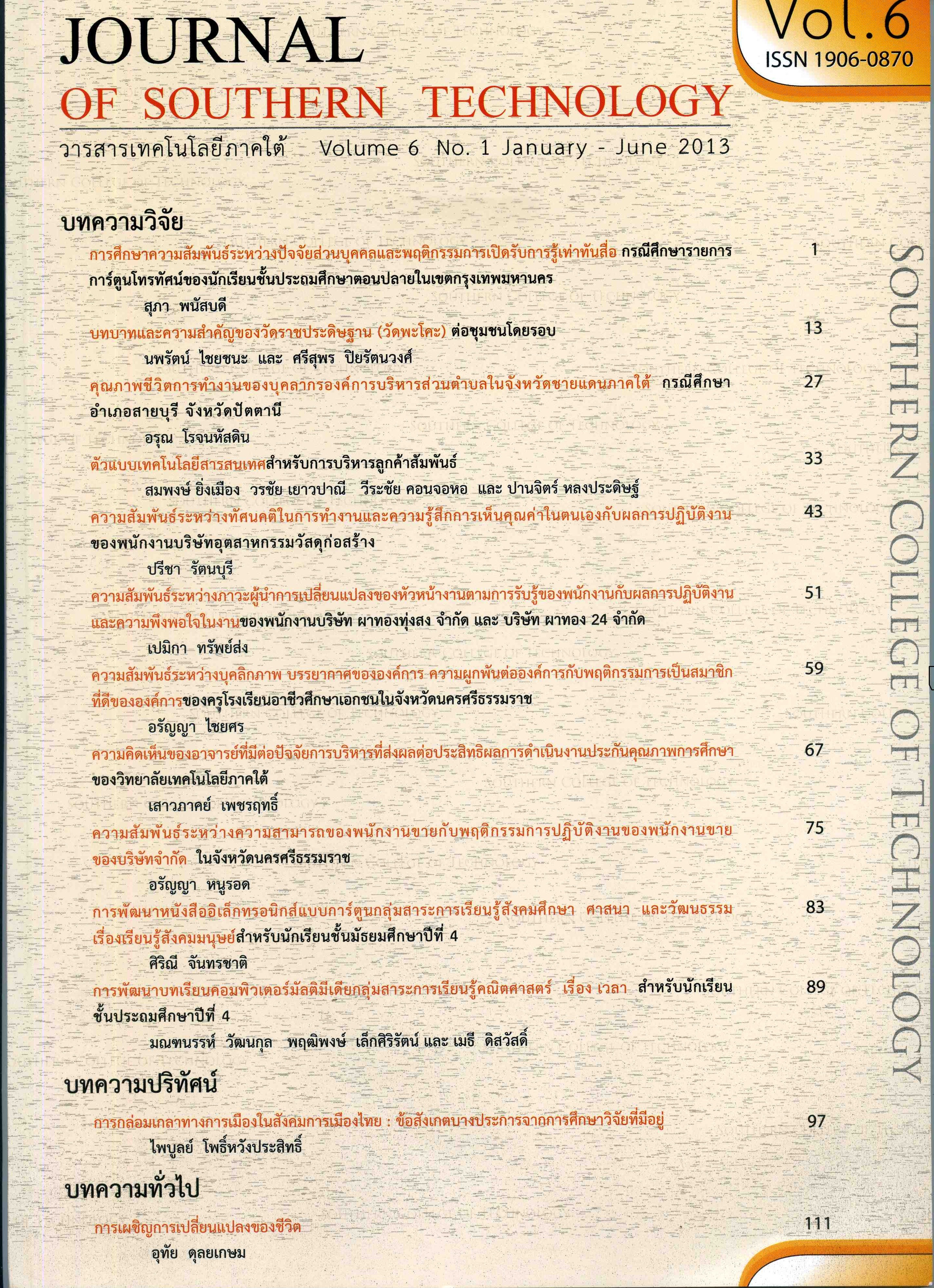Study of the Relationship between Audience Backgrounds and Media Exposure with Media Literacy : A Case of Television Cartoon of Elementary School Students in Bangkok
Main Article Content
Abstract
The purpose of this quantitative research was to study the media literacy of television cartoon in cognitive, emotional, moral, and esthetic dimensions with the relationship of audience backgrounds and media exposure of elementary school students in Bangkok. Four hundred questionnaires were collected from both male and female elementary school students in Bangkok using multistage sampling. Statistical instruments such as frequency, percentage, mean, standard deviation, T-test, and One-way ANOVA at significant level of 0.05 were selected to complete the process of data analysis. The results revealed that the media literacy of television cartoon from elementary school students in Bangkok was in intermediate level of all dimensions. Also, the relationship between the audience age and the esthetic dimension of media literacy was found. In addition, the results found that there was the relationship between parent’s participation and moral, esthetic dimensions. Finally, media format of television cartoon had the relationship with cognitive, emotional, and moral dimensions. This research suggested that both government and television producers should support media literacy for children today to be skillful audience of media literacy tomorrow. Also parents should spend their time to attend television programs with their children to enhance the children’s media literacy skills in all 4 dimensions.
Article Details
-
Authors must agree to the journal publication rules and allow the editors to edit the manuscripts for publication.
-
Author’s right belongs to the author but Journal of Southern Technology holds the right of first publication and thus allow readers to use the article for the purpose of education but not commercial.
References
กระทรวงศึกษาธิการ. (2553). ข้อมูลสารสนเทศด้านการศึกษาของกระทรวงศึกษาธิการ. ค้นเมื่อ 22 เมษายน 2555, จาก http: //www. moe.go.th/data_stat/#ข้อมูล-สถิติด้านการศึกษา
กฤชณัท แสนทวี. (2554). พฤติกรรมการเปิดรับและระดับการรู้เท่าทันสื่อของเยาวชนในเขตกรุงเทพมหานคร. คณะเทคโนโลยีสื่อสารมวลชน, มหาวิทยาลัยเทคโนโลยีราชมงคลพระนคร.
เก็จมณี วรรธนะสิน. (2550). ความคิดเห็นของผู้ปกครองที่มีต่อรายการโทรทัศน์สำหรับเด็ก: กรณีศึกษากลุ่มบูรพา เขตบางกะปิ กรุงเทพมหานคร. วิทยานิพนธ์ศิลป
ศาสตรมหาบัณฑิต, มหาวิทยาลัยราชภัฏธนบุรี.
โครงการเฝ้าระวังสื่อเพื่อสุขภาวะของสังคม. (2551). รายงานผลการศึกษารอบที่ 23 เรื่องการ์ตูนเด็กในฟรีทีวี. ค้นเมื่อ 25 มีนาคม 2555, จาก http://www.mediamonitor. in.th /main/research/docman.html?start=10
จุฑารัตน์ ก๋าเครื่อง. (2554). โฆษณาขนมขบเคี้ยวทางสื่อโทรทัศน์ที่มีผลต่อการรับรู้และการตัดสินใจเลือกบริโภคของเด็กในเขตอำเภอเมือง จังหวัดเชียงใหม่. วิทยานิพนธ์ศิลปศาสตรมหาบัณฑิต สาขาการสื่อสารการศึกษา,มหาวิทยาลัยเชียงใหม่.
ทิพวรรณ ถาวรังกูร. (2553). ความรู้เท่าทันโฆษณาแฝงของผู้ชมรายการชิดหมอในเขตกรุงเทพมหานคร. วิทยานิพนธ์วารสาร ศาสตรมหาบัณฑิต สาขาวิชาการจัดการการสื่อสารองค์กร คณะวารสารศาสตร์และสื่อสารมวลชน, มหาวิทยาลัยธรรมศาสตร์.
ธีรดา หอมคำวะ. (2551). รายการวิทยุโทรทัศน์สำหรับเด็กที่มีผลต่อความพึงพอใจของนักเรียน. วิทยานิพนธ์ศิลปศาสตรมหา บัณฑิต สาขาสื่อสารมวลชน, มหาวิทยาลัยรามคำแหง.
นภัทร เผยฉวี. (2548). พฤติกรรมการเปิดรับชมและความคิดเห็นของนักเรียนชั้นประถม ศึกษาตอนปลายในเขตกรุงเทพมหานครที่มีต่อภาพยนตร์การ์ตูนเรื่องปังปอนด์. วิทยานิพนธ์วารสารศาสตรมหาบัณฑิต สาขาการบริหารสื่อสารมวลชน, มหา วิทยาลัยธรรมศาสตร์.
บุบผา เมฆศรีทองคำ. (2554).การรู้เท่าทันสื่อ: การก้าวทันบนโลกข่าวสาร. วารสารนักบริหาร, 31(1), 117-123.
พสุ ชัยเวฬุ. (2540). การวิเคราะห์เนื้อหารายการ "ช่อง 9 การ์ตูน". วิทยานิพนธ์วารสาร ศาสตรมหาบัณฑิต สาขาสื่อสารมวลชน, มหาวิทยาลัยธรรมศาสตร์.
ภัสวลี นิติเกษตรสุนทร. (2547). การรู้เท่าทันสื่อมวลชน. ใน เอกสารการสอนชุดวิชาความรู้เบื้องต้นเกี่ยวกับสื่อมวลชน หน่วยที่ 9-15. หน้า 299-347. พิมพ์ครั้งที่ 2. นนทบุรี: มหาวิทยาลัยสุโขทัยธรรมาธิราช.
มัทนียา สุวรรณวงศ์. (2542). การวิเคราะห์แนวเรื่องและประเภทเนื้อหาของภาพยนตร์การ์ตูนที่ออกอากาศทางโทรทัศน์. วิทยานิพนธ์วารสารศาสตรมหาบัณฑิต สาขาสื่อสารมวลชน, มหาวิทยาลัย ธรรมศาสตร์.
เมสิริณ ขวัญใจ. (2551). เด็กกับการรู้เท่าทันสื่อโทรทัศน์. วิทยานิพนธ์นิเทศศาสตรมหาบัณฑิต, จุฬาลงกรณ์มหาวิทยาลัย.
วรรณภา วิเชียรโชติ. (2551). การโฆษณาขนมขบเคี้ยวทางโทรทัศน์กับการตั้งใจซื้อของเด็กไทย. วิทยานิพนธ์ศิลปศาสตร มหาบัณฑิต สาขาสื่อสารมวลชน,มหาวิทยาลัยรามคำแหง.
วัฒนชวินท์ กิตติเลิศรัฐ. (2551). ความพึงพอใจของเด็กไทยต่อการชมการ์ตูนต่างประเทศ. วิทยานิพนธ์ศิลปศาสตร มหาบัณฑิต สาขาสื่อสารมวลชน, มหาวิทยาลัยรามคำแหง.
สำนักงานกองทุนสนับสนุนการสร้างเสริมสุขภาพ. (2552). บทความเรื่องนักวิจัยเผย "การ์ตูนช่อง 9” นำเสนอความรุนแรงมากที่สุด.
ค้นเมื่อ 21 เมษายน 2555, จากhttp:// www. matichon.co.th/news_ detail .php?newsid=1236926110&grpid=01&catid=04
สำนักบริการข้อมูลและสารสนเทศ. มหาวิทยาลัยรามคำแหง. (2551). แนวคิดและทฤษฎีเกี่ยวกับการใช้เหตุผลเชิงจริยธรรม.
ค้นเมื่อ 21 กรกฎาคม 2555, จาก http://www.idis.ru.ac.th/report/index.php?topic=5998.0
สุปราณี ปัญจานนท์. (2539). การศึกษาเพื่อวิเคราะห์ความเหมาะสมของรายการการ์ตูนโทรทัศน์สำหรับเด็ก.วิทยานิพนธ์ศึกษาศาสตรมหาบัณฑิต
สาขาเทคโนโลยีการศึกษา, มหาวิทยาลัย เกษตรศาสตร์.
สุรางค์ โค้วตระกูล. (2548). จิตวิทยาการศึกษา. พิมพ์ครั้งที่ 6. กรุงเทพฯ: จุฬาลงกรณ์มหาวิทยาลัย.
อดุลย์ เพียรรุ่งโรจน์. (2543). การศึกษาแนวคิด
เพื่อกำหนดตัวแปรการรู้เท่าทันสื่อสำหรับการวิจัยสื่อสารมวลชน. วิทยานิพนธ์วารสารศาสตรมหาบัณฑิต สาขาการสื่อสารมวลชน, มหาวิทยาลัยธรรมศาสตร์.
เอกสุวัชร์ สิริธัญญ์ภรณ์. (2553). ความพึงพอใจ
ของเด็กต่อการชมการ์ตูนไทย 3 มิติ.
วิทยานิพนธ์ศิลปศาสตรมหาบัณฑิต สาขาเทคโนโลยีสื่อสารมวลชน, มหาวิทยาลัยรามคำแหง.
Blumler, J.G., & Katz, E. (1974). The Uses of Mass Communications: Current Perspectives on Gratifications Research. Beverly Hills, CA: Sage.
Hobbs, R.. & Kubey, R. (2001). Media literacy in the information age: Current perspectives. (6th ed.). USA: Transaction Publishers.
Hobbs, R. & Kubey, R. (2003). Measuring the acquisition of media-literacy skills. Reading Research Quarterly, 38(3), 330.
Jaglom, L. & Gardner, H. (1981). The preschool television viewer as anthropologist, in Kelly, H. and Gardner, H. (eds.) Viewing Children Through Television. San
Francisco: Jossey-Bass.
Lim, L. H., & Theng, Y.-L. (2011). Are youths today media literate? A Singapore study on youth's awareness and perceived confidence in media literacy skills. Proceedings of the American Society for Information Science and Technology, 48, 1–4.
Linder, J. & Gentile, D. (2009). Is the television rating system valid? Indirect, verbal, and physical aggression in programs viewed by fifth grade girls and associations with behavior. Journal of Applied Developmental Psychology,30, 286 - 297.
Messaris, P. (1994). Visual 'Literacy': Image, Mind and Reality. Boulder, Colorado: West view.
Potter, W. J. (2005). Media Literacy.
(3rd ed.). Sage Publications, Inc. United State of America.
Salomon, G. (1979). Interaction of Media, Cognition and Learning. San Francisco: Jossey-Bass.
Smith, R., Anderson, D., & Fisher, C. (1985). Young children’s comprehension of montage, Child Development, 56, 962-71.
Van, E. J. (2004). Television and Child Development. Mahwah, NJ: Erlbaum.

